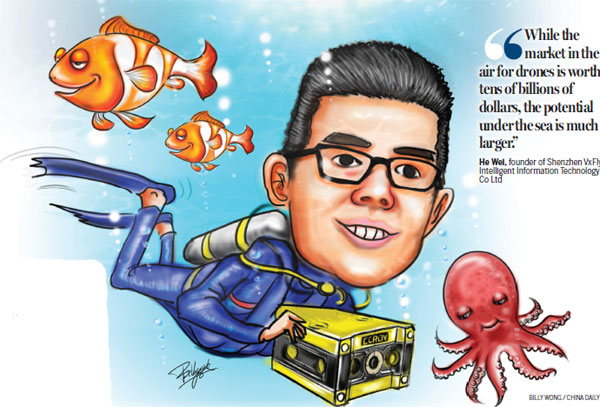Underwater drones swim to unchartered waters
Updated: 2016-10-06 07:16
By Chai Hua in Shenzhen(HK Edition)
|
|||||||||
Unmanned aerial vehicles (UAVs), or commonly known as drones, have quickly become some of the most sought after gadgets in the world.
The UAV market was worth an estimated $10.1 billion in 2015, and is expected to reach $14.9 billion by 2020 at a compound annual growth rate of 8.12 percent, according to researcher MarketsandMarkets.
But now a company in Shenzhen is coming down from the sky and exploring another direction - under the sea.
Shenzhen VxFly Intelligent Information Technology Co Ltd (VxFly) in August revealed an underwater drone, or remote operated vehicle (ROV), for everyday consumers to take photos and film videos underwater.

ROVs can handle situations which are unsafe for human divers, as they can swim deeper and faster than professionals. They also enable those without diving licenses to get a glimpse of the world under the sea.
Traditional ROVs are usually large and used mostly in scientific research and military organizations. But some technology companies introduced ROV products for the consumer market last year, such as the US-based OpenROV's Trident and "Shark" by Tianjin-based Deepfar Ocean Technology Co Ltd.
He Wei, who founded VxFly in February 2015, believes their ROV is "the smallest, easiest and smartest" on the market.
VxFly's underwater drone is called CCROV - the ROV designed to "see the sea". It's molded into a size of a mailbox with a tether, which can be extended to up to 100 meters to enable data transmission underwater. As it's targeting the mass market, the CCROV can be held in someone's hands as its edge lengths are no longer than those of an iPad mini.
The robot can "swim" 1.5 meters per second and reach a maximum depth of 100 meters. With an "eye" of a 4K resolution camera, it can produce 1080p high-resolution digital images and live video of the underwater environment.
Controlled by a smartphone, an iPad or a controller, the CCROV can swim directly downward and turn without any hesitation.
He Wei said his aim is to make CCROV a tool for consumers to explore the sea and capture its beauty, targeting enthusiasts of diving and sailing. In future, a CCROV can be held by the diver during his or her trip under the water.
VxFly launched the product on US-based crowdfunding website Indiegogo in September with the lowest price of $999.
"The robot could bring more fun to their traveling," he said, adding that a diver with a license can dive between 20- to 40-meters deep, but there is much more to explore at greater depths.
The team tested the robot in Huizhou, a coastal city in Guangdong province, where the CCROV reached a depth of 46 meters and found a shipwreck in the process.
"Maybe CCROV could help us find treasure underwater," laughed He.

Aside from shooting photos and videos, the CCROV can also assist in checking boat conditions, underwater temperature and humidity.
"Each time before a boat sails out, sailors need to make a thorough examination of their equipment and our ROV could make the work a lot easier, especially in helping to check the bottom of boats," He said.
Li Zhu, founder of Innovation Angel Funds and an investor in VxFly, believes ROV products can also be applied to ship repairs, and for live broadcasts for underwater sports.
While the market in the air for drones is worth tens of billions of dollars, the potential under the sea is much larger, he said.
Despite VxFly having secured investments of about 5.5 million yuan ($825,000) since March last year, He Wei does not want to rely on investors' funding.
His method to support a 15-month research and development strategy for the CCROV is to first make a product that is relatively easy and quick to generate funds. This led to his team developing a HD digital video transmission system for drones, beaming real-time video from drones to the ground - a project that generates quick cash in the short term.
As the burgeoning market of UAVs has become increasingly competitive, He decided to support his research on ROV projects by tapping into the niche market.
"We have cashed in more than 4 million yuan through the project and another 10 million yuan in orders," he said.
He developed an interest in robots while studying his bachelor and master's degrees at Northwestern Polytechnical University in Shaanxi province, where he won eight prizes in national robot competitions.
His ultimate dream is to create a new underwater ROV industry. He's startup will also develop an online community to share users' photos of the sea and more accessories, such as following shot devices that can transmit an underwater image (up to 20 meters deep) to divers in real time.
He admires drone maker DJI because the company is not only leading the way with its technology but has also created an entirely new industry that has led to drones becoming popular.
grace@chinadailyhk.com
(HK Edition 10/06/2016 page5)